Dances with Flashlight
Flashlight Enthusiast
REVIEW - PEAK'S EL CAPITAN XPG AA / 14500 / 14250
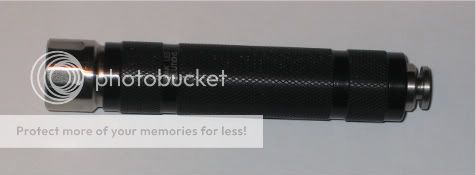
El Capitan HAIII with SS Head and SS Momentary Switch
Like the other lights in Peak's Mountain series, the El Capitan can be had in Brass, Stainless, or black hard anodized aluminum (HAIII). A limited run was produced in very rich looking Gold-plated Brass. Body configurations are: either a pocket body (which is short and lacks any lug or keychain post or rear switch); or a keychain / momentary body illustrated below.
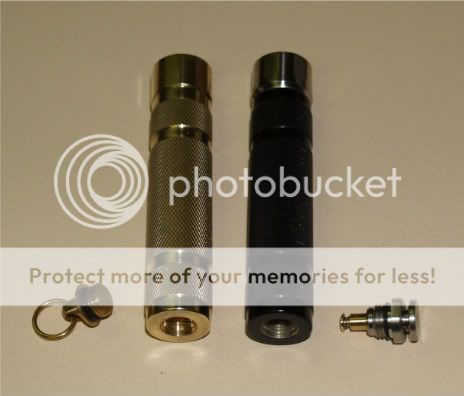
Brass & HAIII El Capitans with Keychain / Momentary Bodies
Over the years Peak has produced several different lights in the single AA configuration. There have basically been two distinct classes of these lights, distinguished principally by their LED's:
First was the AA Kili, available in SS, Brass, HAIII, and limited runs of Titanium and Gold-plated Brass. Within this class, heads were available in various 5mm forms: 1 LED, 5 LED, 7 LED, UV, and an assortment of colored LED's. Output levels were also varied. These were beautifully made, as those familiar with Peaks already know. But 5mm's driven hard were still necessarily limited in performance due to the basic characteristics of 5mm LED's. Next was the AA Kino Bay, built on the same Kili bodies but driven harder and set up for Luxeon emitters.
Then came the AA Pacific models. Peak designed and built this light originally for the Luxeon emitter, and later upgraded it to the P4 LED, driving it with a new electronic board to take advantage of the much greater performance (over the 5mm's) offered by the Luxeons and the P4 LED. It's interesting to note that the diameter of the Pacific body is somewhat greater than that of the El Capitan. The reason for this is that the Kilimanjaro was originally designed exclusively for the AA battery, whereas the Pacific was designed to accommodate both the AA and also the slightly larger CR-2 cell.
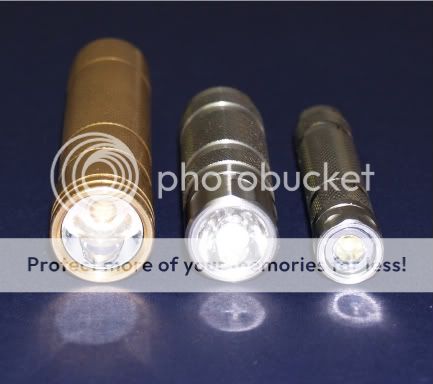
Pacific, El Capitan & Eiger
So now we have the El Capitan. Streamlined like the slim Kili, but substantially outperforming the Pacific because it employs Cree's new high performance XPG LED.
The overall dimensions of the El Capitan are fairly typical for AA lights: 18mm X 96.5mm with the Momentary Switch. Compare the size and weight of the El Capitan to some Peak Pacifics:
The El Cap body and head are .71" in diameter; the Pacific head is .78" with a body of .75". The lengths of these lights with momentary switches are El Cap 3.8" and Pacific 3.95"
With alkaline batteries, the El Cap weighs 2.28oz (64.6g) in HAIII; and the HAIII Pacific weighs 2.39oz (67.6g). For comparison, the brass Pacific weighs 4.68oz (132.8g) with an alkaline battery.8" head
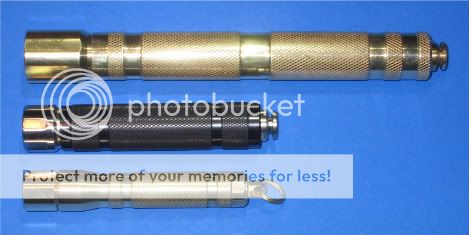
2 AA Caribbean, El Capitan, Baltic
The exterior design of the AA El Capitan in all its variations is both simple and elegant.
On the outside is a straight battery compartment, threaded up front for the El Capitan head. The pocket body is one-ended and machined from bar stock, bored out from the front and closed at the rear. The keychain / momentary body is threaded at the rear with a recess to accept either (i), a keychain adapter, or (ii) an optional bulletproof, momentary switch. The gorgeous brass version has two wide bands of finely crafted knurling which cover most of the length of the body, with smooth rings separating the bands. The knurling is light and not at all aggressive, but entirely adequate for casual use. HAIII models are also knurled in the same pattern used on the earlier SS Matterhorns which were so popular.
As a bonus to Peakaholics, there is knurling also on the stainless steel version. It is not just a smooth threaded tube. Rather, this light in all its variations is milled from solid stock. The heads have milled flats in a stylish pattern. A close inspection reveals that the design format appears identical to that of the Eiger. Very attractive, and tough as nails especially in stainless. Sorry to say - but my pictures just don't do justice to the high quality of this light. If you look carefully, you'll also notice that the keychain posts in the following picture are raw aluminum, the stainless weren't available when I picked these up (and every other keychain post I have just happens to be brass.)
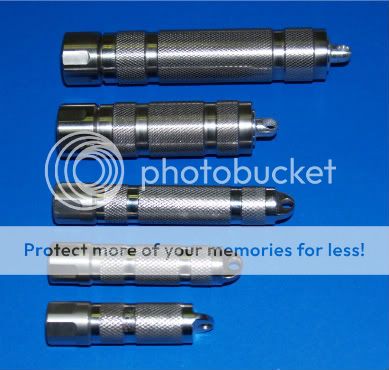
El Capitans in 14500 & 14250; Eigers in 10440, 10280 & 10180
As already noted, El Capitan heads, bodies, and keychain posts are manufactured in Brass, Stainless, and HAIII, and can be mixed and matched to suit your tastes. Same with the momentary switches, but these are manufactured only in Brass and SS, not in HAIII.
Workmanship is superb with very tight tolerances in all machined parts. Both the brass and stainless polish up very, very nicely. Frankly, Brass Peaks in particular are so beautifully made it ought to be a crime not to polish them.
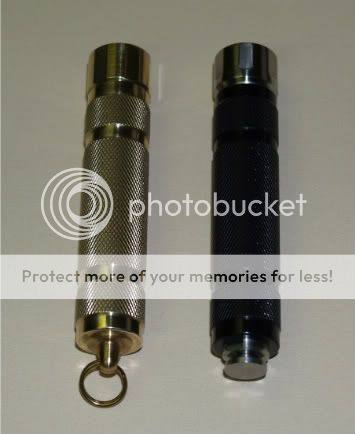
Polished Brass Keychain & HAIII w/ SS Head & Momentary
On the other hand, there are those who prefer the richness of an aged patina. As an aside, and as others have noted in other posts, a polished brass Peak carried in a pocket seems to retain its polish longer, and develop a patina slower, than one carried on a keychain. The HAIII finish is a semi-gloss black, not gray, and is even across the entire light without any visible variations in color. The HAIII head and tail post are anodized at the same time so they will match. Threads are tight and silky smooth, especially in brass, but the SS and HAIII, although very precisely machined, should be lightly lubricated. If you haven't already done so, check out Tekno Cowboy's Comprehensive Grease and Lube Sticky for a wealth of info on the lubes you may wish to use. I have been using a silicone faucet grease with great results. However, use any dielectric (non-conducting) grease very sparingly since this can impair current flow as I've learned the hard way - too much will cause flickering and can even prevent the light from firing at all.
An O-ring on the head provides a snug fit to prevent the light from being twisted on unintentionally, and also to seal the battery compartment which holds a single AA or 14500 battery, positive terminal facing forward. The negative contact is at the tail end of the case, and in the keychain style this contact is inserted into a recess that also accepts the keychain adapter. A neat feature of the keychain style is that the light can be removed from the keychain simply by twisting the tail end of the light off its adapter which will stay attached to the keyring. Even with the adapter removed in this way, the light remains waterproof. The optional momentary switch is inserted into the same recess and replaces both the separate negative contact and the keychain adapter. The switch is actually a very small unit that is even shorter than the keychain adapter it replaces.
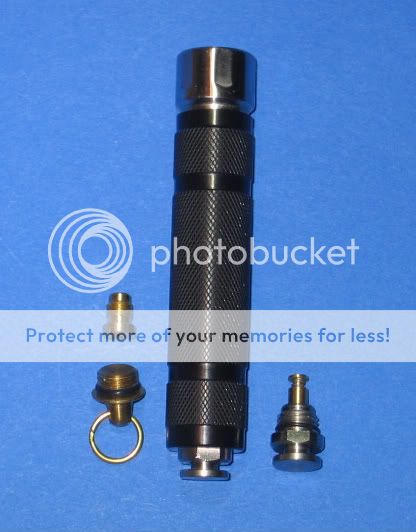
The Keychain body accepts either configuration
A small foam washer at the tail end prevents battery rattle. Another O-ring is used to prevent water intrusion at the rear of the body. These O-rings all seem to work well, probably because of the close tolerances in the design and manufacture - I've never observed any water entry in any Peak light. Because the O-rings are subject to abrasion during twisting of the body, they should also be lubricated lightly.
Operation is as simple as it gets: twist the head on, and twist it off.
With the momentary switch installed, the depth of the head is initially adjusted by twisting it into the body until the momentary switch operates with the desired level of sensitivity - a quick and easy adjustment. Even with the momentary switch installed, the head can be twisted to the on position for more convenient extended use. The spring-loaded momentary switch does not click on or off - it is a very simple device that allows current to flow when depressed. It is completely silent. The operating button is wide and beefy and available in either brass or stainless.
For those familiar with Peak's momentary switches, this is the very same tried and true, smoothly operating switch also used in Peak's Matterhorn, Eiger, Pacific and Caribbean series of lights. I can't say enough about the momentary switch for these lights. Nothing could be quicker or more convenient to operate and it's ideal especially for those uses that are of short duration.
The El Capitan uses a single AA sized cell of any battery chemistry presently available, primary or rechargeable. The light is specifically designed to handle any 1.2v rechargeable NiMH, 1.5v alkaline, or 3.7v rechargeable 14500 LiIon battery.
Peak is also producing the El Capitan with a shorter body to accommodate the 14250 LiIon battery. This body is just about one inch shorter than the AA sized body making for a very compact powerhouse of a light. In the pocket body it's actually even shorter than a lugged 10280 Eiger!
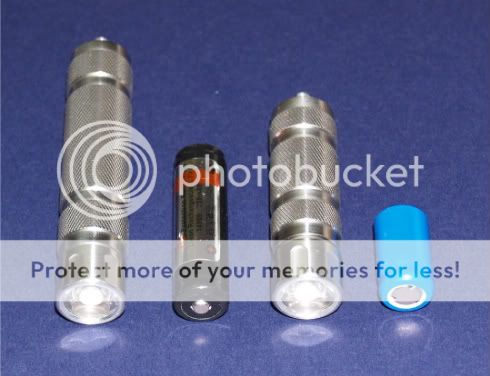
SS El Capitans in 14500 & 14250
Now, an important point about battery length: AW's protected 14500's seem to be measurably longer than most other AA/14500 cells - too long for an El Capitan set up for standard AA's or unprotected 14500's. The added length of a protected 14500 is troublesome even with the momentary body. The bottom line is that the length of these protected cells prevents turning down the head of the light far enough to completely cover the O-ring. But there is a solution: on request Peak will furnish the light with a shorter negative contact to remedy the situation for those who intend to use the protected 14500's.
Heat produced by hungry LED's powered by 3.7v LiIon cells to maximum output is something to write home about. Earlier LED's, not as efficient as the XPG, wasted more energy - waste in the form of heat. The XPG, however, converts more of the available power into lumens and loses less through heat. As a result, and despite its relatively small size, the El Capitan runs much cooler than the Pacific driven hard with the same 3.7v battery. This is also partly due to the effectiveness of Peak's heat management methodology. The circuit board and heatsink, like those of all Peaks, are potted (totally encased) for protection against shock and moisture in a heat-transferring epoxy. The El Capitan uses the same reliable circuitry Peak has used in all its Rebel and P4 lights. The positive contact at the rear of the head is a very solid gold-plated brass button. No soft solder blob to deform.
The LED used in the current production is an R4 bin Cree XPG in lower power units, with an R5 now being installed in higher power lights. However, as indicated above, when the R5's become available in quantity these will be used exclusively, Colored XPE's may be available soon on special order.
Unlike the Eiger which is produced in wide, medium and narrow beam profiles, the El Capitan is available at this time in just two profiles - medium or narrow, both with collimating optics. The relatively shallow Kili head does not permit the use of a longer reflector that might ordinarily be required for a narrower beam. But Peak now employs a collimating optic for the XPG to achieve a narrower beam profile for a much tighter hotspot and greater resulting throw. The LED and optic are protected with a lexan window. These are not the same optics used in the Eiger. They are new optics sized for the El Capitan head, but the beam pattern in the medium is very similar to that of the Medium Eiger which has a broad hot spot with respectable (but not dramatic) throw and a wide, even spill. The narrow profile, although it doesn't affect total lumen output at all, produces a substantially smaller hotspot and an increase in apparent intensity estimated by Peak at 85% above that of the medium.
The beam profiles with either optic are beautiful: very, very clean without any rings or unevenness or shadows or artifacts of any kind. The medium configuration is ideal for the general uses of lights of this size. The medium El Capitan was not designed to be a thrower - it delivers instead a huge volume of light over a wide area within a reasonable range. The narrow, on the other hand, especially with LiIons, is definitely in the thrower category.
I will post some beamshots, but please be patient - I haven't yet learned how to capture them.
A particular advantage of the El Capitan (like the AAA Eiger) is that it is manufactured and can be ordered in any one of eight different power levels ranging from fairly dim and very long-running (Level 1), to maximum brightness with little if any regard for runtime (Level 8). You pick. It is, however, a single level light with no strobes, SOS mode, or variable outputs.
Performance with a single 1.5v cell is dramatic. I never believed an ordinary AA battery could produce so much light. But with a 3.7v Lithium Ion battery the output of this state of the art light is simply unbelievable. Not too long ago, much larger lights using two CR-123 lithium batteries for 65 to 120 lumens were classed and marketed as tactical. The El Capitan would serve very well as a pocket backup to a duty light for a LEO.
There is a vast difference in performance from the Level 1 to the Level 8 lights. Total lumens at Level 1 should be low enough to satisfy most anyone slinking around the house at night without waking others - something in the neighborhood of 7 lumens with alkaline and 16 lumens with a LiIon. Level 4 output should be about 16 lumens with alkaline and 35 lumens with a LiIon. Output at Level 8 with an alkaline is said to be about 54 lumens, and approximately 130 lumens with a 3.7v LiIon. Note that these values are for the R4 bin XPG. The R5's should increase total lumens by another 10% or so.
I am not much of a judge of tints and still like the nice blue tints on my old 5mm's, but I can't see any tint at all in the El Capitan. I was specifically told that mine has a very slight greenish tint, but neither I nor anyone else I've shown it to can detect any color at all, even when compared to other lights against bright white walls and paper. Anyway, from what I've seen with my old, lying eyes, the tint, or lack of it, is perfect. The Cree XPG is apparently delivered in bulk kits which contain emitters of varying tints. These new Peaks are therefore going to be subject, like all others using these Crees, to the "tint lottery" about which much has previously been written.
More compact and more capable than the trusted Pacific, with performance equal or superior to much larger and far more expensive lights, the El Capitan sets a very high mark for a new class of lights. And like all Peaks, it is beautifully made with many build and performance options. It is a superb light, built to serve and to last.

Last edited:




